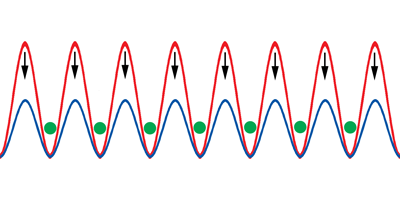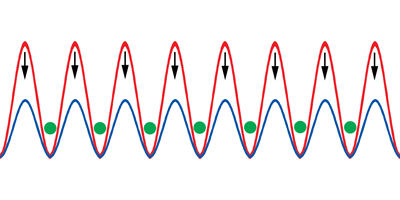Wave of Correlation
A textbook problem in quantum physics is to calculate the ground state of a particle confined to a box and then ask what happens if the box is suddenly doubled in size. Even though real quantum systems like solids are considerably more complex, optical lattices, which are crossed laser beams that trap arrays of atoms in an egg-carton-like potential, are sufficiently tunable that physicists can rapidly change the trapping potential and observe how atoms respond. Writing in Physical Review A, Peter Barmettler at the University of Geneva, Switzerland, and colleagues calculate how quickly the effects of this “quantum quench” travel through a system with many interacting particles.
As in relativistic systems, where the speed of light limits how quickly information travels, in many-body systems there is a maximum velocity with which changes in one particle will ripple through to its neighbors. Experimentalists have measured the speed of these correlations in atoms trapped in a one-dimensional optical lattice after suddenly changing the optical potential. Barmettler et al., who collaborated on the experiments, model the atoms as a chain of bosons with an adjustable strength of interactions between the particles relative to their kinetic energy. By taking a new approach, which they describe in detail in the current paper, they are able to calculate the velocity of correlations for both strongly and weakly interacting atoms.
In addition to helping interpret optical lattice experiments, Barmettler et al.’s work could be applicable to studying thermalization in quantum many-body systems. – Jessica Thomas





